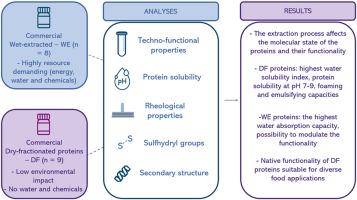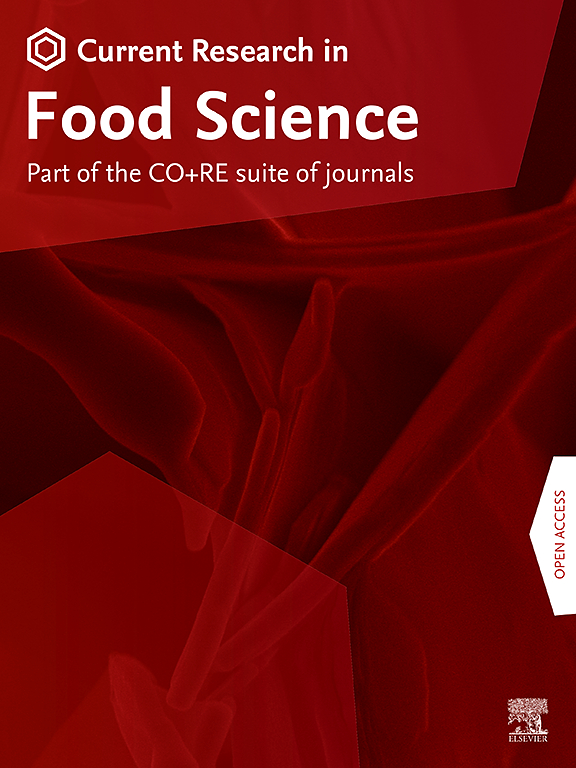通过干法分馏和湿法提取获得的植物蛋白成分的技术功能、流变学和化学特性
IF 6.2
2区 农林科学
Q1 FOOD SCIENCE & TECHNOLOGY
引用次数: 0
摘要
干法分馏技术对环境的影响最小,而且适用于各种植物来源,因此是生产植物蛋白配料的一项前景广阔的技术。由于缺乏对其物理化学、流变学和化学特性的广泛了解,干法分馏蛋白质仍处于开发阶段,在食品工业中的应用有限。湿法提取虽然应用广泛,但耗能、耗水、耗化学品。本研究调查了通过湿法提取(WE,n = 8)和干法分馏(DF,n = 9)获得的各种植物物种的商业蛋白质成分的技术功能、流变学和化学特性,以确定其潜在的食品应用。与干法分馏成分相比,湿法萃取蛋白质在 pH 值为 7 和 9 时的水溶性指数和蛋白质溶解度最低,起泡和乳化能力也最低。对二级结构的分析表明,WE 成分中存在变性蛋白质结构,而二级结构中存在较多的无规线圈结构。相反,非变性结构与碳水化合物等其他成分的结合可能是 DF 蛋白成分具有高溶解性和胶凝特性的原因。湿法萃取技术可以广泛调节配料的功能,为食品应用提供广泛的范围,而干法分馏技术似乎只能保证较窄范围的技术功能特性,但在某些领域(如溶解性和发泡)可能具有更高的性能。本文章由计算机程序翻译,如有差异,请以英文原文为准。

Techno-functional, rheological, and chemical properties of plant-based protein ingredients obtained with dry fractionation and wet extraction
Dry fractionation is a promising technology for producing plant protein ingredients, owing to its minimal environmental impact and adaptability to diverse plant sources. Dry-fractionated proteins are still under development with limited applications in food industry due to lack of extensive knowledge about their physicochemical, rheological and chemical properties. Wet extraction though widely used, consumes high energy, water, and chemicals. In this research, the techno-functional, rheological, and chemical properties of commercial protein ingredients of various botanical species obtained via wet extraction (WE, n = 8) and dry fractionation (DF, n = 9) were investigated in order to identify their potential food applications. Compared to DF ingredients, WE proteins showed the lowest water solubility index and protein solubility at pH 7 and 9, as well as the lowest foaming and emulsifying capacities. This behavior can be explained by the presence of denatured protein structures in WE ingredients as suggested by the analysis of the secondary structure which revealed a higher presence of random coil structures. On the contrary, the presence of non-denatured structures in combination with other constituents like carbohydrates may have contributed to the high solubility and gelling properties of the DF proteins ingredients. While wet extraction technologies can offer a wide modulation of ingredient functionality, providing a broad spectrum of food applications, dry fractionation seems to guarantee a narrow range of techno-functional properties, although with potentially higher performance in certain areas like solubility and foaming.
求助全文
通过发布文献求助,成功后即可免费获取论文全文。
去求助
来源期刊

Current Research in Food Science
Agricultural and Biological Sciences-Food Science
CiteScore
7.40
自引率
3.20%
发文量
232
审稿时长
84 days
期刊介绍:
Current Research in Food Science is an international peer-reviewed journal dedicated to advancing the breadth of knowledge in the field of food science. It serves as a platform for publishing original research articles and short communications that encompass a wide array of topics, including food chemistry, physics, microbiology, nutrition, nutraceuticals, process and package engineering, materials science, food sustainability, and food security. By covering these diverse areas, the journal aims to provide a comprehensive source of the latest scientific findings and technological advancements that are shaping the future of the food industry. The journal's scope is designed to address the multidisciplinary nature of food science, reflecting its commitment to promoting innovation and ensuring the safety and quality of the food supply.
 求助内容:
求助内容: 应助结果提醒方式:
应助结果提醒方式:


